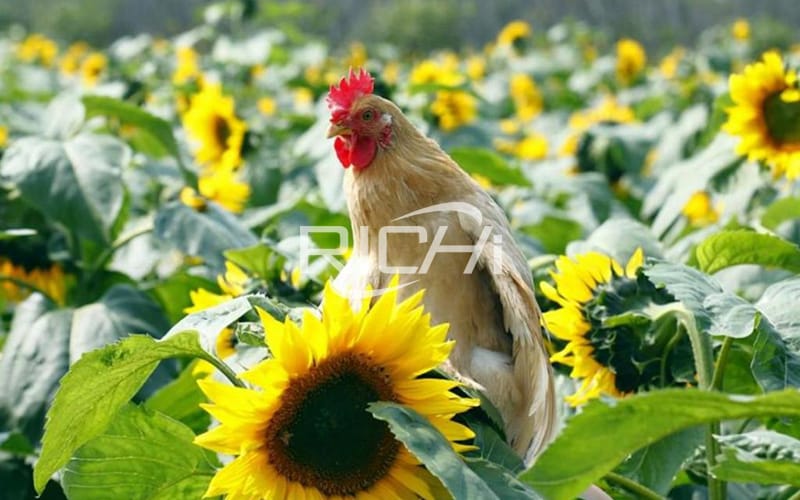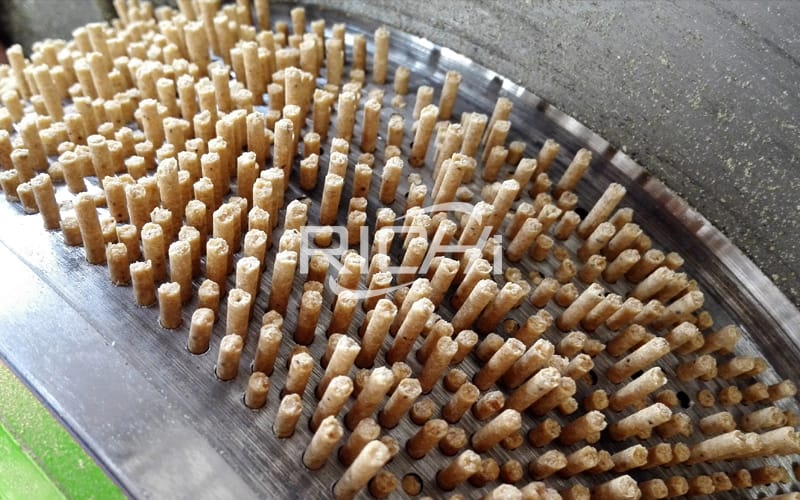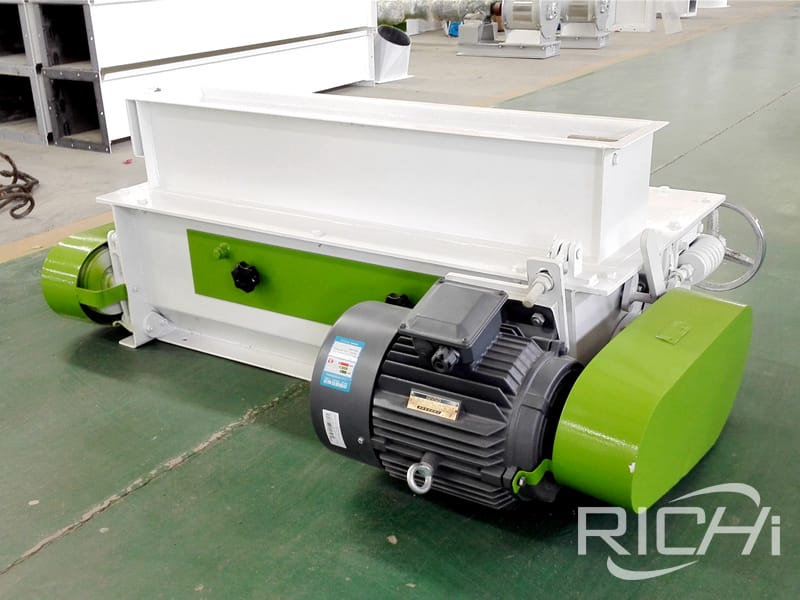Today's theme:FAQs about broiler chicken feed pellet and poultry chicken feed processing machines

Is it better to feed broilers with pellets or powder?
As a product of the modern chicken industry, chicken feed pellets are made by chicken pellet making machine. The pellet size can be adjusted to meet the needs of different broilers. Generally, the diameter of the early material is 0.1-0.2 cm, and the diameter of the later material is 0.3 cm. Broiler feeding industries in developed countries generally use pellets. Its biggest advantage is to ensure that all nutrients are balanced when the broilers eat the feed, and what they eat is the real compound feed.
Broiler pellets can also improve the palatability, make the broiler eat a large amount, more easily achieve the nutritional indicators required by the production performance, and reduce the waste of feed. Due to the high temperature during the pressing process, it is also a sterilization process for Salmonella and other bacteria. During the processing of pellets, the carbohydrates in the feed are gelatinized and the digestibility of the feed is improved. There are advantages and disadvantages. The high temperature during processing can easily destroy certain nutrients, especially some vitamins. The improved method is to granulate first, and then spray the vitamins evenly on the surface of the chicken pellets. Due to the additional process, the processing cost will increase.
There are generally two feeding methods for powder, one is free intake of dry powder, or it can be mixed into wet powder and fed at regular intervals. The dry powder feed method is simple and suitable for large-scale breeding. It does not need to be specially cleaned and the feed will not deteriorate, but it is easy to cause uneven nutrient intake, because the material at the bottom of the trough and barrel is thin and heavy. The feed is thick and light, and the bottom feed of the chicken is less, which is easy to cause the problem of incomplete feeding. Another problem is that when longitudinal ventilation is used in the chicken house, there will be a lot of dust at the air outlet, which is also the reason for feeding dry powder. Wet mixing can promote more feeding, and can also be fed with green fodder, but it is only suitable for small-scale feeding, and the feed trough must be scrubbed regularly to prevent feed deterioration, especially in summer, not to mix too much wet material at a time.
From the perspective of feeding science, it is good for broilers to eat pellets. But from an economic point of view, if self-mixing is used, feeding powder may be more beneficial than feeding pellets. When raising broilers on a small scale, feeding wet mixes can overcome the shortcomings of inadequate intake of nutrients.

Is it good to use pellet feed for broiler chickens?
Pellet feed is a compound feed plus a binder that is compressed by a pellet machine. The pellet size is different and diverse, which can meet the needs of young chicks, middle chicks and later broilers. The biggest advantage of pellet feed is that the broilers eat comprehensive nutrition and the ratio is stable. Powdered compound feed undergoes processes such as packaging, transportation, conveying, and feeding, and uneven nutrient separation often occurs. This is because the thickness of various feed ingredients is different, the specific gravity is different, and the texture separation occurs, which makes the originally mixed feed become less uniform.
In particular, a chain feeder is used. The feed at the bottom of the trough is thin and heavy, and the feed at the top is thicker and lighter. The feed at the bottom of the chain cannot be eaten. This makes the chickens eat incomplete nutrients and affects the growth rate of the chickens. This kind of situation will not occur in pellet feed, and it is easy to eat, with a large feed intake, and the weight gain effect is obvious, without the waste of feed. At present, pellet feed is widely used in broiler production. The size of the broiler pellet is generally about 0.3 cm. Using a pellet crumbler to crush the pellets into smaller pellets for the chicks to eat, the effect is much better than using mash feed.
About crumblers:
We produce a wide range of crumblers: It is used to crumble the pellet after pelleting and cooling to obtain feed for small animals. Every crumb keeps the complete formula’s characteristics, avoiding selection of feed from the animal.
Technical characteristics of our crumblers:
- (1)Machine structure in electric welded steel plate at suitable thickness.
- (2)Higher part of the alimentation of the crumbler with bulkhead powered by a pneumatic cylinder for the roller by-pass.
- (3)Manual adjusting system for the distance between the rollers with springs to protect them from the entrance of possible metallic pieces.
- (4)Part of the power by a motor for each roller with belt transmission.

What are the common feed ingredients for broilers
Common feeds for broilers can be divided into energy, protein, minerals, vitamins and additive feeds according to their nutritional content.
- (1) Energy feed is rich in starch, sugar and fiber, with low protein content and insufficient amino acids. Commonly used energy feeds for broilers mainly include corn, wheat, barley, broken rice and bran.
- (2) Protein feed is rich in protein and various essential amino acids. The commonly used protein feeds for broilers mainly include soybean meal, corn gluten meal, rape meal, cotton meal, peanut meal, fish meal, blood meal and feather meal.
- (3) Mineral feed is a type of feed used to supplement the lack of certain minerals in plant and animal feeds, mainly including stone powder, shell powder, bone meal, salt, calcium hydrogen phosphate, zeolite and gravel.
- (4) The commonly used vitamin feeds for broilers are mainly industrial single-synthetic vitamins and multivitamins. Under normal circumstances, vitamins are relatively lacking. In addition to adding according to nutritional requirements, it is also necessary to consider the composition of the diet, animal physiological conditions and environmental conditions. Generally, the addition amount should be about 1 times more than the required amount.
- (5) Commonly used additive feeds for broilers are mainly to prevent the degradation of feed quality, improve the utilization of nutrients in the feed, promote growth, and improve health. Small or trace amounts of nutrients or non-nutritive ingredients are added to the compound feed. There are enzyme preparations, feed quality improvers, coloring agents, antibiotics, microbial preparations, Chinese herbal medicines, and insect repellent health care agents.
What is the difference between broiler powder and broiler pellet feed? Which feed-to-meat ratio is higher?
Judging from the current global research results, the benefits of pellets must be higher than powder. Otherwise, the process of granulating with a granulator will not be used. Because the pellets are matured, but the pellets have an increase in production cost, this should also be considered in the final benefit calculation.
However, it is not necessary for the farmers. It must be viewed from several aspects: (1) Is it a mind-set, the powder has been used before, but suddenly it is not suitable for pellets; (2) Induction by other manufacturers; (3) ) It is necessary to add self-dressing materials, etc. in the feeding process. Of course, there may be other factors. After all, all links may affect the production efficiency of broilers, and farmers may attribute these reasons to the pellets.
Is it better to use wheat or wheat middlings in broiler feed?
The wheat middlings is added to the feed to increase the viscosity of the feed and easily form particles. If you add too much, it will be too hard, difficult to digest, low in energy, and inferior to wheat in nutritional indicators. It's best not to use sub-powder entirely, it's not good Flour, leftovers from flour mills, is hygienic and prone to diarrhea. Do not add more than 5% in an appropriate amount, because its amino acid level is not as good as wheat, and it is mainly wheat. (Wheat middlings, also known as black flour, yellow flour, lower or third-class flour, etc., is a by-product of wheat processing, mainly composed of finely crushed bran and part of wheat endosperm. It is obtained by grinding various flours from wheat grains. )
Is the broiler feed white or yellow?
In general broiler feed ingredients, only a limited number of energy feeds such as secondary meal and wheat bran are close to white. Corn and soybean meal are yellowish, and fish meal is brown. Therefore, if adulteration is not considered, dark-colored feed nutrition It should be better than lighter ones.
Feed broilers with complete formula feed. Can corn meal be added later?
Not recommended to add! Generally, the complete formula feed pellets is very comprehensive! You can lick and add fat if you want to increase the energy in the feed, but it will be more troublesome in winter! You have to heat the fat and spray it evenly on the feed and mix well! Energy, protein, vitamins and trace elements are the four major parts of broiler feed. Now the complete formula feed is very mature. If you add corn, you may cause your chickens to overfeed. Whether the corn has mold or dry humidity Whether it meets the standards is a question. Some essential amino acids, lysine, methionine, etc. can be added.


